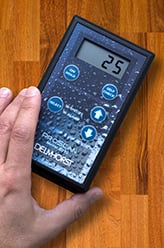 Pinless moisture meters are used by many professionals in the restoration and home inspection industries to rapidly check for moisture in different building materials.
Pinless moisture meters are used by many professionals in the restoration and home inspection industries to rapidly check for moisture in different building materials.
These meters have several distinct advantages that can make them preferable to a pin-type meter:
- Speed. It’s easier to press a pinless meter against a flat surface and take a reading than it is to push two metal pins into building materials. With pinless meters, you can quickly take multiple readings at different points in a flat surface, making them great for doing preliminary evaluations on a job site.
- Non Destructive Moisture Measurement. Pinless meters use an electromagnetic radio frequency to detect moisture. This noninvasive method allows you to measure the moisture content of building materials without having to put holes into its surface.
These advantages make pinless moisture meters ideal when you need to cover a large area quickly and thoroughly without causing damage to the material being checked—such as when you’re checking moisture in drywall and hardwood floors before taking pin readings.
Are There Times Where You Don’t Want to Use a Pinless Meter?
Pinless meters are great tools for restoration specialists and home inspectors, but there are times where they might not be the best tool to use.
Situations where pinless meters might not be as useful as pin-type meters include:
- Uneven Surfaces. To get an accurate reading, the entire scanning plate for a pinless meter needs to make contact with the surface of the material being tested. Gaps caused by an uneven or curved surface can negatively impact readings.
- Scanning Especially Thick/Thin Materials. Pinless meters scan to a fixed depth. If the material being scanned is too thick, then you may not get a complete profile of the material’s moisture content. Too thin, and you may get moisture readings for objects behind the material being scanned.
- When You Need to Know the Distribution of Moisture in Wood or Other Materials. Because pinless meters scan a large area all at once, the reading they provide is an average of the moisture content they detect over that area. This is great for finding moisture; but not so good for getting an exact comparison of core vs. shell moisture content when you need it, or for hidden moisture that might be present behind drywall, or in a subfloor underneath a hardwood floor.
In these instances, a pin-type meter would be better-suited for filling your moisture measurement needs. Because of this, it’s often a good idea to have both kinds of meters when you’re on the job.
2-in-1 meters that combine reference scale pinless meters with pin meter functionality can provide the best of both worlds in a single device; maximizing performance and convenience when you’re on the job.
Need a rugged, accurate moisture meter you can rely on? Check out Delmhorst’s moisture meters today!

Comments